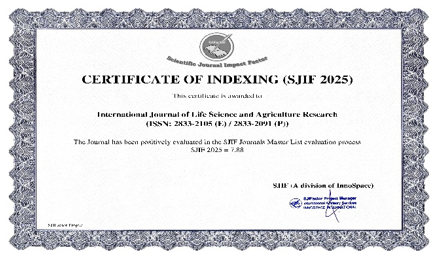Application of Liquid Organic Fertilizer (LOF) From Vegetable Waste and NPK on the Growth and Results of Corn (Zea Mays L.)
DOI:
https://doi.org/10.55677/ijlsar/V02I08Y2023-05Keywords:
Corn, Liquid Organic Fertilizer. NPK fertilizerAbstract
Liquid Organic Fertilizer (LOF) and NPK fertilizer are fertilizers that are often used as additional nutrients in the soil to increase the productivity of agricultural products. This experiment aims to test the level of effectiveness and benefits of LOF on corn plants of the Paragon variety, and to provide a comparison between LOF and NPK fertilizer in the analysis of production and farming economics. This experiment was carried out from August to December 2022 at the Experimental Field of the Soil Fertility and Plant Nutrition Chemistry Laboratory, Department of Soil Science and Land Resources, Faculty of Agriculture, University of Padjadjaran Jatinangor, Sumedang Regency, West Java with an altitude of ± 750 meters above sea level . The experiment was carried out using the field trial method with a randomized block design (RBD) consisting of 6 treatments and repeated 4 times, namely 4 treatments with LOF doses, 1 treatment with recommended fertilizer and 1 control treatment. The results of the experiment showed that LOF treatment with NPK fertilizer had an effect on plant height, crown diameter, number of leaves, cob diameter, cob length, fresh and peeled cob weight, crop yield, and farm income. Based on the considerations of this experiment, LOF has met the requirements as a LOF that is suitable for use as a complementary nutrient supplement by combining single NPK fertilizers (Urea, Sp-36, and KCl). 1 treatment with recommended fertilizer and 1 control treatment. The results of the experiment showed that LOF treatment with NPK fertilizer had an effect on plant height, crown diameter, number of leaves, cob diameter, cob length, fresh and peeled cob weight, crop yield, and farm income. Based on the considerations of this experiment, LOF has met the requirements as a LOF that is suitable for use as a complementary nutrient supplement by combining single NPK fertilizers (Urea, Sp-36, and KCl). 1 treatment with recommended fertilizer and 1 control treatment. The results of the experiment showed that LOF treatment with NPK fertilizer had an effect on plant height, crown diameter, number of leaves, cob diameter, cob length, fresh and peeled cob weight, crop yield, and farm income. Based on the considerations of this experiment, LOF has met the requirements as a LOF that is suitable for use as a complementary nutrient supplement by combining single NPK fertilizers (Urea, Sp-36, and KCl).
References
Agricultural Research and Development Agency. 2005. Technical Guidelines for Chemical Analysis of Soil, Plants, Water and Fertilizers. Soil Research Institute. Bogor.
Djohar, Adityo Wibowo. 2009. Characteristics of Some Chemical Properties of Andisol in Main Materials and Different Geological Formations in Bandung Regency, West Java.
Farastuti, D., & Henuhili, V. 2018. The Effect of Variations in Fertilizer Types on the Growth and Development of Tomato Plants (Lycopersicum esculentum var. Intan). Biology-S1, 7(6), 429-440.
Firmansyah, I., Syakir, M., &Lukman, L. 2017. The Influence of Dose Combination of N, P, and K Fertilizers on the Growth and Yield of Eggplant (Solanum melongena L.)[The Influence of Dose Combination Fertilizer N, P, and K on Growth and Yield of Eggplant Crops (Solanum melongena L.)]. Journal of Horticulture, 27(1), 69-78.
Gardner, FP, Pearce RB and Mitchell, RL 1991. Translation: Susilo and Subiyanto. Cultivation Plant Physiology. University of Indonesia Publisher (UI Press), Jakarta.
Hardjowigeno, Sarwono. 2015. Soil Science. Pressindo Academy. Jakarta
Kasno A. 2006. A Profitable Alternative Green Beans Planted in Dry Land. PT Duta Karya Private. Jakarta.
Lingga P, Marsono. 2011. Instructions for Using Fertilizers. Jakarta (ID): Independent Spreader.
Mahdiannoor, N. Istiqomah, and Syarifudin. 2016. Application of LOF on the Growth and Yield of Sweet Corn. Ziraa'ah Journal, vol. 41 no. 1. Pages 1 – 10.
Mashtura, SP, Sufardi, S., & Syakur, S. 2013. Effects of Phosphate and Sulfur Fertilization on Growth and Nutrient Uptake and Yield Efficiency of Lowland Rice (Oryza sativa L.). Journal of Land Resource Management, 2(3), 285-295.
Pardosi, AH, Irianto, and Mukhsin. 2014. Response of Corn Plants to LOF of Vegetable Waste on Ultisol Dry Land. Proceedings of the National Seminar on Suboptimal Land
Regulation of the Minister of Agriculture Number 43/Permentan/SR.140/8/2011 Concerning Organic Fertilizers, LOF and Soil Repairers.
Center for Soil and Agro-climatic Research (PUSLITATANAK). 2000. Indonesian Land Resources and Management. Agricultural Research and Development Agency, Ministry of Agriculture.
Rosmarkam and Nasih Widya Yuwono. 2002. Soil Fertility Science. Canisius. Yogyakarta
Suwahyono, Lucky. 2011. Practical Instructions for Using Organic Fertilizers Effectively and Efficiently. Jakarta: Independent Spreader.
Wasonowati, C. 2011. Increasing the growth of tomato plants (Lycopersicum esculentum Mill) with a hydroponic cultivation system. Agrovigor volume 4. Pp 21-28.
Wihardjaka, A. Poniman. 2015. Contribution of Sulfur Nutrients to Rice Productivity and Greenhouse Gas Emissions in Paddy Fields. Food Crops Science and Technology, 10(1), 9-17.












